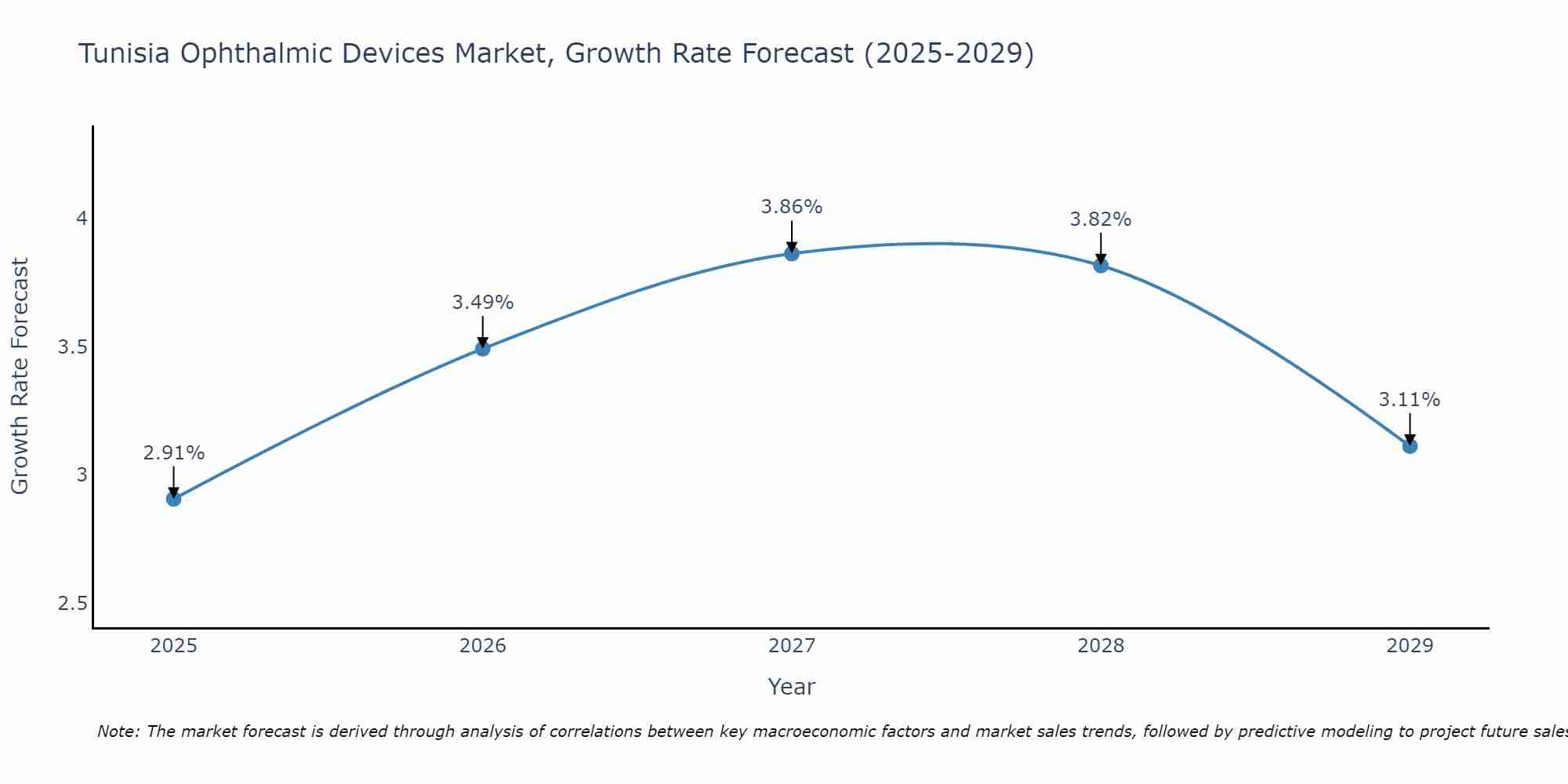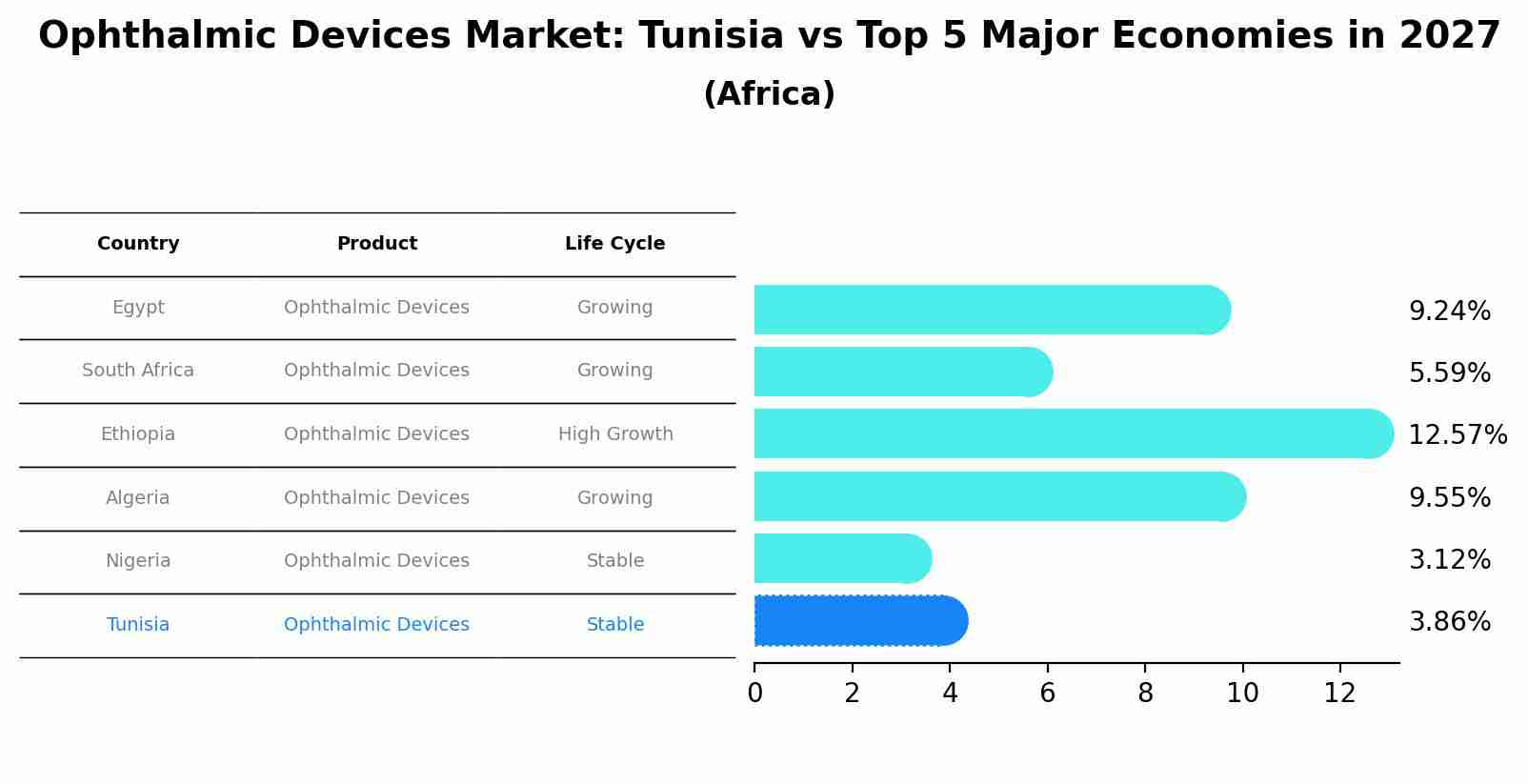Tunisia Ophthalmic Devices Market Outlook | Value, Size, Companies, Industry, Trends, Forecast, COVID-19 IMPACT, Share, Growth, Analysis & Revenue
| Product Code: ETC367914 | Publication Date: Aug 2022 | Updated Date: Jul 2025 | Product Type: Market Research Report | |
| Publisher: 6Wresearch | Author: Ravi Bhandari | No. of Pages: 75 | No. of Figures: 35 | No. of Tables: 20 |
Tunisia Ophthalmic Devices Market Size Growth Rate
The Tunisia Ophthalmic Devices Market is projected to witness mixed growth rate patterns during 2025 to 2029. Starting at 2.91% in 2025, the market peaks at 3.86% in 2027, and settles at 3.11% by 2029.

Ophthalmic Devices Market: Tunisia vs Top 5 Major Economies in 2027 (Africa)
Tunisia's Ophthalmic Devices market is anticipated to experience a stable growth rate of 3.86% by 2027, reflecting trends observed in the largest economy Egypt, followed by South Africa, Ethiopia, Algeria and Nigeria.

Tunisia Ophthalmic Devices Market Synopsis
The Tunisia Ophthalmic Devices Market is experiencing steady growth due to increasing prevalence of eye diseases, advancements in technology, and growing awareness about eye health. Key market segments include diagnostic devices (such as optical coherence tomography and fundus cameras), surgical devices (including phacoemulsification systems and vitrectomy machines), and vision care products (such as contact lenses and glasses). With a rising aging population and a growing demand for refractive surgeries, the market is expected to expand further. Key players in the Tunisia Ophthalmic Devices Market include multinational companies like Alcon, Bausch + Lomb, and Carl Zeiss, as well as local manufacturers and distributors. Regulatory reforms and investments in healthcare infrastructure are also influencing market dynamics, making Tunisia an attractive destination for ophthalmic device manufacturers.
Tunisia Ophthalmic Devices Market Trends
The Tunisia Ophthalmic Devices Market is experiencing several key trends. One prominent trend is the increasing demand for advanced technology and innovative products in the field of ophthalmology. This includes the adoption of cutting-edge diagnostic equipment, surgical devices, and vision correction solutions. Additionally, there is a growing focus on providing more personalized and customized treatment options to cater to individual patient needs. Another trend is the rising prevalence of eye disorders and age-related vision problems, driving the demand for ophthalmic devices and services. Furthermore, there is a noticeable shift towards minimally invasive procedures and outpatient treatments, leading to the development of compact and portable ophthalmic devices that offer convenience and flexibility for both patients and healthcare providers in Tunisia.
Tunisia Ophthalmic Devices Market Challenges
In the Tunisia Ophthalmic Devices Market, some key challenges include limited access to advanced technology and equipment, high import costs, and a shortage of skilled ophthalmologists. The market faces constraints in terms of infrastructure and resources necessary for the adoption of cutting-edge ophthalmic devices, which can hinder advancements in diagnosis and treatment. Additionally, the high costs associated with importing ophthalmic devices pose a barrier for smaller clinics and healthcare facilities. Furthermore, there is a shortage of trained ophthalmologists in Tunisia, leading to a strain on healthcare resources and potentially impacting the quality of eye care services provided. Addressing these challenges will require investments in technology, training programs for healthcare professionals, and potentially, policy reforms to improve access to essential ophthalmic devices and services in the country.
Tunisia Ophthalmic Devices Market Investment Opportunities
The Tunisia Ophthalmic Devices Market presents a range of investment opportunities due to factors such as the increasing prevalence of eye disorders and the growing demand for advanced eye care services. Investors can consider opportunities in areas like diagnostic devices, surgical instruments, and vision correction products. With the government`s focus on improving healthcare infrastructure and increasing access to eye care services, there is potential for growth in the market. Partnerships with local healthcare providers and distributors can also be beneficial for investors looking to enter the Tunisia Ophthalmic Devices Market. Additionally, technological advancements in the field of ophthalmology present opportunities for innovative products and solutions to meet the evolving needs of patients and healthcare professionals.
Jordan Agar Market Government Policies
The Tunisian government regulates the ophthalmic devices market through the Ministry of Health, which oversees the registration and approval process for medical devices, including ophthalmic equipment. The government has implemented regulations to ensure the safety, quality, and efficacy of ophthalmic devices available in the market, requiring manufacturers to adhere to strict standards and obtain proper certifications. Import regulations are also in place to control the entry of ophthalmic devices into the country, with importers needing to comply with specific requirements and obtain necessary permits. Additionally, the government may provide subsidies or incentives to promote the adoption of advanced ophthalmic technologies and improve access to eye care services for the population. Overall, government policies in Tunisia aim to foster a competitive and sustainable ophthalmic devices market while safeguarding public health and ensuring the availability of high-quality products.
Tunisia Ophthalmic Devices Market Future Outlook
The Tunisia ophthalmic devices market is projected to show steady growth in the coming years, driven by factors such as increasing prevalence of eye disorders, growing aging population, and rising awareness about eye health. Technological advancements in ophthalmic devices, such as advanced diagnostics and surgical equipment, are also expected to fuel market growth. Additionally, government initiatives to improve healthcare infrastructure and accessibility to eye care services will contribute to market expansion. However, challenges such as limited healthcare resources and infrastructure in certain regions may hinder the market growth to some extent. Overall, the Tunisia ophthalmic devices market is likely to witness positive growth trends in the future, presenting opportunities for market players to innovate and expand their presence in the region.
Key Highlights of the Report:
- Tunisia Ophthalmic Devices Market Outlook
- Market Size of Tunisia Ophthalmic Devices Market, 2021
- Forecast of Tunisia Ophthalmic Devices Market, 2031
- Historical Data and Forecast of Tunisia Ophthalmic Devices Revenues & Volume for the Period 2018 - 2031
- Tunisia Ophthalmic Devices Market Trend Evolution
- Tunisia Ophthalmic Devices Market Drivers and Challenges
- Tunisia Ophthalmic Devices Price Trends
- Tunisia Ophthalmic Devices Porter's Five Forces
- Tunisia Ophthalmic Devices Industry Life Cycle
- Historical Data and Forecast of Tunisia Ophthalmic Devices Market Revenues & Volume By Product for the Period 2018 - 2031
- Historical Data and Forecast of Tunisia Ophthalmic Devices Market Revenues & Volume By Optical Coherence Tomography Scanners for the Period 2018 - 2031
- Historical Data and Forecast of Tunisia Ophthalmic Devices Market Revenues & Volume By Fundus Cameras for the Period 2018 - 2031
- Historical Data and Forecast of Tunisia Ophthalmic Devices Market Revenues & Volume By Perimeters/Visual Field Analyzers for the Period 2018 - 2031
- Historical Data and Forecast of Tunisia Ophthalmic Devices Market Revenues & Volume By Autorefractors and Keratometers for the Period 2018 - 2031
- Historical Data and Forecast of Tunisia Ophthalmic Devices Market Revenues & Volume By Ophthalmic Ultrasound Imaging Systems for the Period 2018 - 2031
- Historical Data and Forecast of Tunisia Ophthalmic Devices Market Revenues & Volume By Ophthalmic Pachymeters for the Period 2018 - 2031
- Historical Data and Forecast of Tunisia Ophthalmic Devices Market Revenues & Volume By Tonometers for the Period 2018 - 2031
- Historical Data and Forecast of Tunisia Optical Coherence Tomography Scanners Ophthalmic Devices Market Revenues & Volume By Slit Lamps for the Period 2018 - 2031
- Historical Data and Forecast of Tunisia Ophthalmic Devices Market Revenues & Volume By Application for the Period 2018 - 2031
- Historical Data and Forecast of Tunisia Ophthalmic Devices Market Revenues & Volume By Cataract for the Period 2018 - 2031
- Historical Data and Forecast of Tunisia Ophthalmic Devices Market Revenues & Volume By Vitreo retinal disorders for the Period 2018 - 2031
- Historical Data and Forecast of Tunisia Ophthalmic Devices Market Revenues & Volume By Glaucoma for the Period 2018 - 2031
- Historical Data and Forecast of Tunisia Ophthalmic Devices Market Revenues & Volume By Refractor Disorders for the Period 2018 - 2031
- Historical Data and Forecast of Tunisia Ophthalmic Devices Market Revenues & Volume By End-use for the Period 2018 - 2031
- Historical Data and Forecast of Tunisia Ophthalmic Devices Market Revenues & Volume By Hospitals and Eye Clinics for the Period 2018 - 2031
- Historical Data and Forecast of Tunisia Ophthalmic Devices Market Revenues & Volume By Academic and Research Laboratory for the Period 2018 - 2031
- Historical Data and Forecast of Tunisia Ophthalmic Devices Market Revenues & Volume By Others for the Period 2018 - 2031
- Tunisia Ophthalmic Devices Import Export Trade Statistics
- Market Opportunity Assessment By Product
- Market Opportunity Assessment By Application
- Market Opportunity Assessment By End-use
- Tunisia Ophthalmic Devices Top Companies Market Share
- Tunisia Ophthalmic Devices Competitive Benchmarking By Technical and Operational Parameters
- Tunisia Ophthalmic Devices Company Profiles
- Tunisia Ophthalmic Devices Key Strategic Recommendations
Frequently Asked Questions About the Market Study (FAQs):
- Single User License$ 1,995
- Department License$ 2,400
- Site License$ 3,120
- Global License$ 3,795
Search
Related Reports
- ASEAN Bearings Market (2025-2031) | Strategy, Consumer Insights, Analysis, Investment Trends, Opportunities, Growth, Size, Share, Industry, Revenue, Segments, Value, Segmentation, Supply, Forecast, Restraints, Outlook, Competition, Drivers, Trends, Demand, Pricing Analysis, Competitive, Strategic Insights, Companies, Challenges
- Europe Flooring Market (2025-2031) | Outlook, Share, Industry, Trends, Forecast, Companies, Revenue, Size, Analysis, Growth & Value
- Saudi Arabia Manlift Market (2025-2031) | Outlook, Size, Growth, Trends, Companies, Industry, Revenue, Value, Share, Forecast & Analysis
- Uganda Excavator, Crane, and Wheel Loaders Market (2025-2031) | Strategy, Consumer Insights, Analysis, Investment Trends, Opportunities, Growth, Size, Share, Industry, Revenue, Segments, Value, Segmentation, Supply, Forecast, Restraints, Outlook, Competition, Drivers, Trends, Demand, Pricing Analysis, Competitive, Strategic Insights, Companies, Challenges
- Rwanda Excavator, Crane, and Wheel Loaders Market (2025-2031) | Strategy, Consumer Insights, Analysis, Investment Trends, Opportunities, Growth, Size, Share, Industry, Revenue, Segments, Value, Segmentation, Supply, Forecast, Restraints, Outlook, Competition, Drivers, Trends, Demand, Pricing Analysis, Competitive, Strategic Insights, Companies, Challenges
- Kenya Excavator, Crane, and Wheel Loaders Market (2025-2031) | Strategy, Consumer Insights, Analysis, Investment Trends, Opportunities, Growth, Size, Share, Industry, Revenue, Segments, Value, Segmentation, Supply, Forecast, Restraints, Outlook, Competition, Drivers, Trends, Demand, Pricing Analysis, Competitive, Strategic Insights, Companies, Challenges
- Angola Excavator, Crane, and Wheel Loaders Market (2025-2031) | Strategy, Consumer Insights, Analysis, Investment Trends, Opportunities, Growth, Size, Share, Industry, Revenue, Segments, Value, Segmentation, Supply, Forecast, Restraints, Outlook, Competition, Drivers, Trends, Demand, Pricing Analysis, Competitive, Strategic Insights, Companies, Challenges
- Israel Intelligent Transport System Market (2025-2031) | Strategy, Consumer Insights, Analysis, Investment Trends, Opportunities, Growth, Size, Share, Industry, Revenue, Segments, Value, Segmentation, Supply, Forecast, Restraints, Outlook, Competition, Drivers, Trends, Demand, Pricing Analysis, Competitive, Strategic Insights, Companies, Challenges
- Uganda Precast and Aggregate Market (2025-2031) | Strategy, Consumer Insights, Analysis, Investment Trends, Opportunities, Growth, Size, Share, Industry, Revenue, Segments, Value, Segmentation, Supply, Forecast, Restraints, Outlook, Competition, Drivers, Trends, Demand, Pricing Analysis, Competitive, Strategic Insights, Companies, Challenges
- Australia IT Asset Disposal Market (2025-2031) | Strategy, Consumer Insights, Analysis, Investment Trends, Opportunities, Growth, Size, Share, Industry, Revenue, Segments, Value, Segmentation, Supply, Forecast, Restraints, Outlook, Competition, Drivers, Trends, Demand, Pricing Analysis, Competitive, Strategic Insights, Companies, Challenges
Industry Events and Analyst Meet
Our Clients
Whitepaper
- Middle East & Africa Commercial Security Market Click here to view more.
- Middle East & Africa Fire Safety Systems & Equipment Market Click here to view more.
- GCC Drone Market Click here to view more.
- Middle East Lighting Fixture Market Click here to view more.
- GCC Physical & Perimeter Security Market Click here to view more.
6WResearch In News
- Doha a strategic location for EV manufacturing hub: IPA Qatar
- Demand for luxury TVs surging in the GCC, says Samsung
- Empowering Growth: The Thriving Journey of Bangladesh’s Cable Industry
- Demand for luxury TVs surging in the GCC, says Samsung
- Video call with a traditional healer? Once unthinkable, it’s now common in South Africa
- Intelligent Buildings To Smooth GCC’s Path To Net Zero













